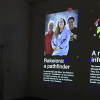Machine Learning meets dentistry: Predictive models forecast 3D-printed dental material longevity
Dental restorations, including denture teeth, should be tailored to the patient’s individual functional and aesthetic needs.
An important part of this customisation is wear-related data, initially produced through laboratory testing, then refined with clinical results. Now, it’s important to understand how both conventional and the new 3-D additively manufactured (AM) methods and materials for dental restorations behave over time – particularly in wear, longevity and aesthetic appearance.
Project challenges
Up-to-date data is essential to evaluate the performance of new materials and fabrication methods. But measuring wear is time-intensive and typically spans years under clinical conditions. Laboratory simulations require approximately 96 hours per sample, with over 120 tests often needed to evaluate and compare materials.
No standardised approach exists to test or predicting wear across material types even with available ISO standards. University of Otago PhD student Anastasiia (Ana) Grymak sought to find best wear testing method and to develop a predictive methodology.
What was done
Ana’s thesis investigated ‘Correlation of three wear test modules and post-analysis methods for dental materials.’ She used data from the project to explore whether a predictive method could be developed.
The research project unfolded in two stages.
First, a pilot study used a simplified Long Short-Term Memory (LSTM) model to estimate how long different dental restoration materials could resist reciprocating wear. This allowed Ana to simulate material behaviour over 12, 24, and 48 months in a controlled environment.
NeSI data scientist Maxime Rio supported the project by advising on suitable methodologies for wear prediction based on available data, and by assisting with code development, refinement, and optimisation.
With Maxime’s support, Ana gained expertise in High Performance Computing (HPC), data logging, and coding. Their collaboration enabled efficient data processing and simulations, culminating in published results in the Journal of the Mechanical Behaviour of Biomedical Materials. Ana presented her findings at an International Association for Dental, Oral, and Craniofacial Research (IADR) dental conference in Bogota, Colombia.
In the second phase, Ana developed different LSTM-based algorithm models to predict wear in 3D-printed materials across three testing methods. The purpose was to create model that is capable of generalising and predicting the wear regardless of method, material, type of load or environment.
The collected data was used to develop models for estimating the wear of restorative dental materials over significant period of times.
Running the model required substantial computational power, far beyond the capabilities of a regular laptop. NeSI’s systems enabled Ana to efficiently process the data and run the simulations.
Main outcomes
The initial study showed that 3D printed materials have more acceptable wear performance compared to conventional and milled alternatives.
Ana and her team also developed a successful predictive algorithm to predict wear of various dental restorative materials with promising prediction accuracy (up to 85% during the pilot study and up to 92% during development of second type of algorithm). This was validated against real-time data collected on dental wear in the laboratory.
This proof of concept paves the way for further technical improvements - existing materials can be tested under different conditions, and new materials can be evaluated in considerably less time.
This will ultimately save time, money and material usage and support dental clinicians in decision-making with their patients.
Researcher feedback
The process for predicting wear for dental materials didn’t exist before in the dentistry field – there wasn’t any standards for transforming the data across wear methods, nor an indication if classical algorithms would be suitable for such a task. Approaching NeSI consultancy gave us a cool opportunity to see what was possible using AI and how it could be applied in dentistry, creating interdisciplinary research.
NeSI’s support alongside that from the University of Otago was critical, empowering students to engage in interdisciplinary research with expert support, broadening our skills and perspectives. New Zealand is so fortunate to have this.






